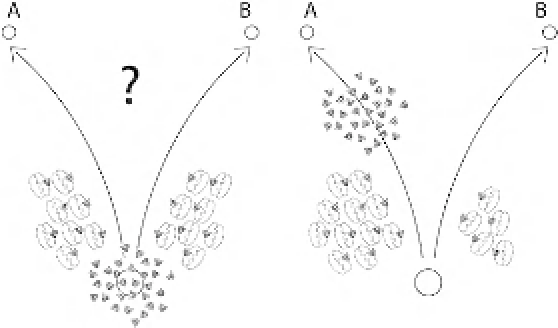Biomedical Engineering Reference
In-Depth Information
FIGURE 13.4
Four communication methods used by bees in the decision-making process when selecting a new nest site.
make them more receptive to other signals and
thus play a role both in nest-site selection and in
decisions on when the swarm should take off. (3)
A piping signal appears after a decision on a nest
site has been reached and consists of a high-
pitched noise produced by pressing the bee's
body to a surface or to another bee. It is a signal
for other bees to warm up their flight muscles.
(4) A buzz run occurs shortly before lift-off and
is done by the same bees that performed the pip-
ing signals. It consists of running across the sur-
face of the swarm while buzzing the wings every
second and eventually triggers the lift-off.
Let us now focus on what happens during the
decision-making process, i.e., before piping sig-
nals and buzz runs occur. A number of scouts
leave the swarm to fly off in different directions
to search for suitable nest sites. Once located,
they return to the swarm to advertise for the
nest sites with waggle dances. The better the
site, the longer and more vigorous the dance. In
addition, scouts visiting good sites use a stop
signal toward scouts waggle dancing for other
nest sites
[17]
. The signal consists of the bee
touching its head against the dancing bee while
emitting a high-frequency vibration signal.
Although one stop signal is not enough to stop
a waggle dance, the more stop signals a dancing
bee receives, the more likely she is to abandon
her waggle dance. The process of advertisement
and inhibitory signals means that the preference
for the different sites (measured as the number
of scouts waggle dancing for them) will change
over time. Eventually, usually within a day, a
consensus is reached such that the majority of
scouts advertise for the same location, as illus-
trated in
Figure 13.5
[18]
. When this consensus
is reached, some scouts start emitting the piping
signal, followed by the buzz run and migration
of the swarm to the chosen nest site. Thus the
queen is not involved in the decision of which
location is going to be the site of the new nest.
Instead, it is determined by a
democratic
process
of a convergence of preferences by the majority
of the scouting honeybees.
One example of a planned human behavior
with similarities to the bee decision-making
behavior is described by Hansen and Lenau
[19]
.
The behavior of a team of engineering design
students is influenced so they can easily follow
the work of other teams. The students make
extensive use of worksheets on which they
FIGURE 13.5
Part of the decision-making process when
the bee swarm determines which nest site to choose.


